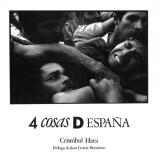Vanitas
by Cristobal Hara
Photographs: Cristóbal Hara
Text: Ignacio González
Publisher: PhotoVision / Mestizo
96 pages
Pictures: 76
Year: 1998
ISBN: 84-86620-13-9
Comments: 28 x 30 cm, hardcover with dustjacket, 1st original edition, perfect condition.
As in the paintings known by the name VANITAS, death has a habit of making an appearance in many aspects of Spanish culture -from the poetry of Teresa de Jesús to that of García Lorca; from the images of Goya to those of Dalí, and in the still very vital world of the bullfight. It provides an austere backdrop which enhances the vitality and colour of the Spanish spirit.
In this book Cristóbal Hara takes death as his travelling companion on a voyage to the furthest corners of the country and returns with images which sum up -better than the guidebooks and the monuments- that special personality which Spain still manages to retain.
However, what is really happening in Vanitas is the burial of the stereotyped images of the so-called &Mac179;Eternal Spain&Mac178; -and it is irony which deals them their death-blow, situating them accurately in present-day in Spain today, without diminishing their immense cultural value.
VANITAS is also a book about photographic language itself, and its effects, taking in both the formal aspect of image-construction and that of contextualisation.
More books by Cristobal Hara
Random selection from the Virtual bookshelf josefchladek.com
Vanitas
by Cristobal Hara
Photographs: Cristóbal Hara
Text: Ignacio González
Publisher: PhotoVision / Mestizo
96 pages
Pictures: 76
Year: 1998
ISBN: 84-86620-13-9
Comments: 28 x 30 cm, hardcover with dustjacket, 1st original edition, perfect condition.
As in the paintings known by the name VANITAS, death has a habit of making an appearance in many aspects of Spanish culture -from the poetry of Teresa de Jesús to that of García Lorca; from the images of Goya to those of Dalí, and in the still very vital world of the bullfight. It provides an austere backdrop which enhances the vitality and colour of the Spanish spirit.
In this book Cristóbal Hara takes death as his travelling companion on a voyage to the furthest corners of the country and returns with images which sum up -better than the guidebooks and the monuments- that special personality which Spain still manages to retain.
However, what is really happening in Vanitas is the burial of the stereotyped images of the so-called &Mac179;Eternal Spain&Mac178; -and it is irony which deals them their death-blow, situating them accurately in present-day in Spain today, without diminishing their immense cultural value.
VANITAS is also a book about photographic language itself, and its effects, taking in both the formal aspect of image-construction and that of contextualisation.
More books by Cristobal Hara
Random selection from the Virtual bookshelf josefchladek.com
Vanitas
by Cristobal Hara
Photographs: Cristóbal Hara
Text: Ignacio González
Publisher: PhotoVision / Mestizo
96 pages
Pictures: 76
Year: 1998
ISBN: 84-86620-13-9
Comments: 28 x 30 cm, hardcover with dustjacket, 1st original edition, perfect condition.
As in the paintings known by the name VANITAS, death has a habit of making an appearance in many aspects of Spanish culture -from the poetry of Teresa de Jesús to that of García Lorca; from the images of Goya to those of Dalí, and in the still very vital world of the bullfight. It provides an austere backdrop which enhances the vitality and colour of the Spanish spirit.
In this book Cristóbal Hara takes death as his travelling companion on a voyage to the furthest corners of the country and returns with images which sum up -better than the guidebooks and the monuments- that special personality which Spain still manages to retain.
However, what is really happening in Vanitas is the burial of the stereotyped images of the so-called &Mac179;Eternal Spain&Mac178; -and it is irony which deals them their death-blow, situating them accurately in present-day in Spain today, without diminishing their immense cultural value.
VANITAS is also a book about photographic language itself, and its effects, taking in both the formal aspect of image-construction and that of contextualisation.
More books by Cristobal Hara
Random selection from the Virtual bookshelf josefchladek.com






;jpg?c=480a4902eea6385f6b3949426b14a6cd)










;jpg?c=c2a419ba84d0f4711c14771e5e2ff802)
